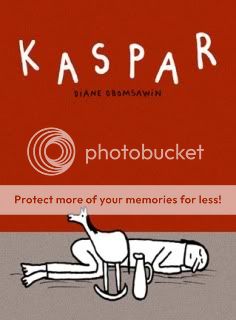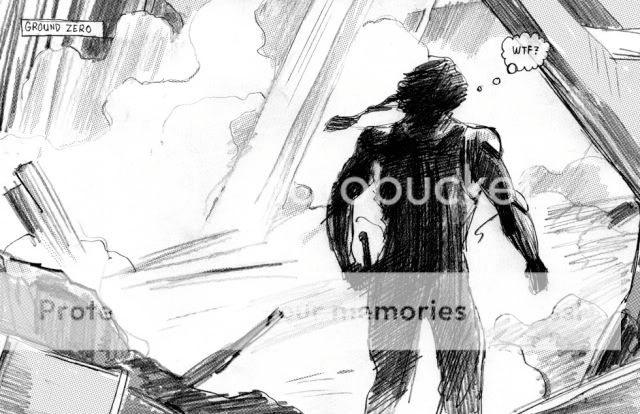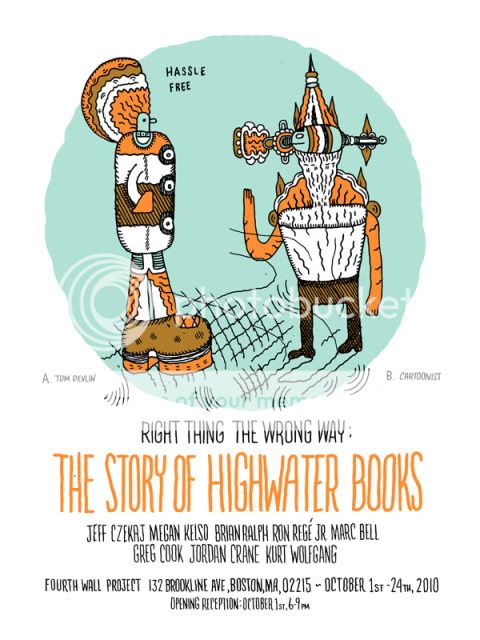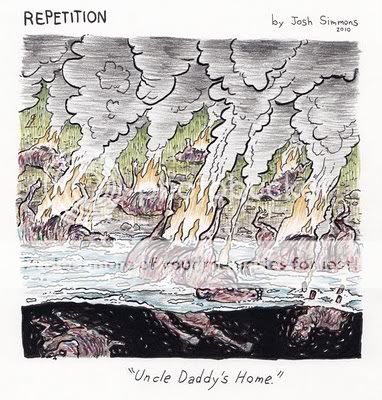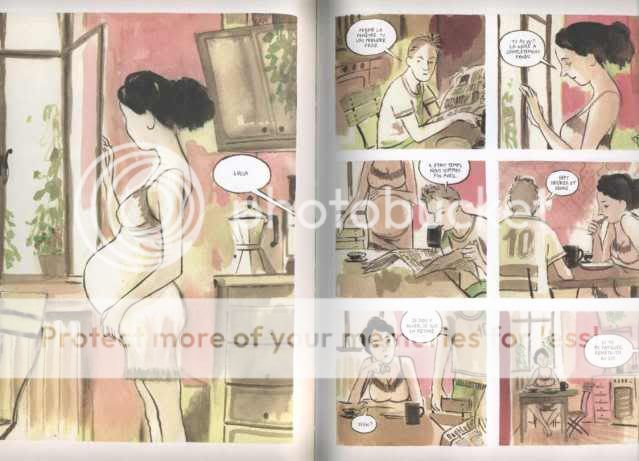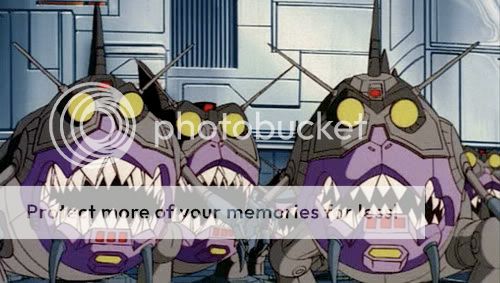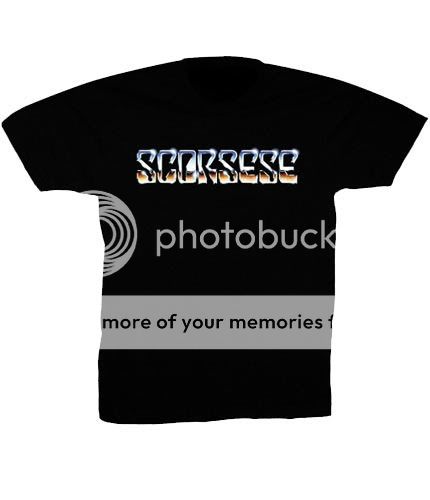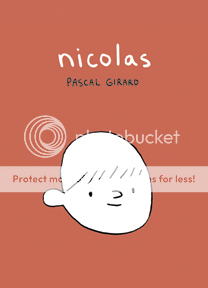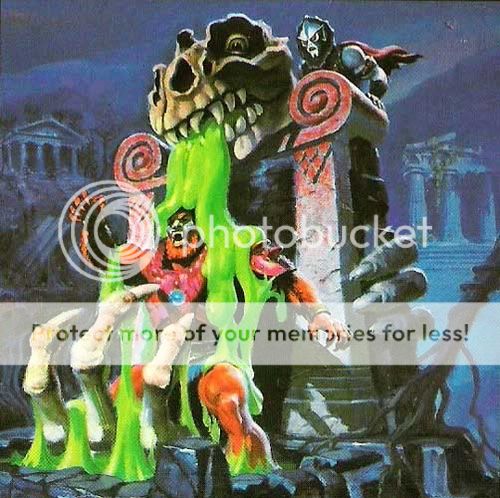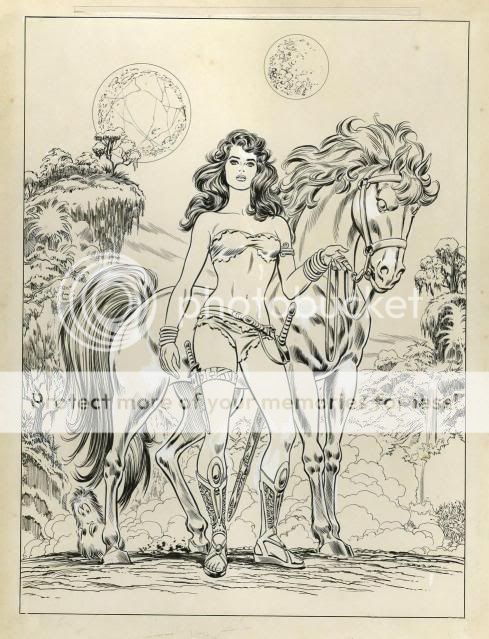Archive for September 8, 2010
Comics Time: Kaspar
September 8, 2010Kaspar
Diane Obamsawin, writer/artist
Drawn & Quarterly, January 2009
96 pages
$12.95
Again with the brown for the cover, but alright, fine, I’m clearly on the losing end of this aesthetic battle with D&Q and I accept that. What’s far more interesting here, and it’s a shame if the drab cover (not to mention the choice of grayscale for the interiors) obscure this, is the story of Kaspar itself. Or rather himself–Obomsawin here traces through contemporaneous accounts the life of one Kaspar Hauser, who for five years around 1830 intrigued and baffled European society with his amazing story of spending his first 16 years kept in total isolation with no human contact whatsoever before being taught some rudimentary language and handwriting by a mysterious man in black who then left him in Nuremberg to fend for himself. Kaspar’s story is one of a kind of cruelty my mind and soul virtually invert themselves to avoid having to deal with–I’m reminded of the story my wife told me from one of her psych courses, about a 19th-century experiment that used loud noises to condition a baby to be so afraid of bunnies that eventually he couldn’t even see a cotton ball without screaming. There’s something so unspeakably awful about human beings harming the human beinghood of a child right from the start that when I came across lines from Kaspar like “There is straw on the ground where I sit and sleep–it never occurs to me to want to stand up,” or the idea that he doesn’t know there even is anything else but himself, the bread and water he’s brought while sleeping, and the toy horse he’s locked up with, part of me just wants to run and hide. The trick of the book upon Hauser’s Chauncey Gardiner-like entrance into high society is using his literal inability to fathom the cruelty done to him (how can he–until now he had no context for what he was missing) and his appreciation for simple things like the color red or the concept of distance as a proxy for our own rejection of such monstrousness and a way to awaken our own lust for life respectively.
Of course, a visit to Wikipedia reveals that Hauser was almost certainly a peerless goldbricker, something his various patrons almost all cottoned to eventually, and from which the mysterious accidents and “assaults” that repeatedly befell and eventually killed him were likely self-inflicted to distract. Obomsawin’s choices to tell the story from Kaspar’s first-person perspective and to draw it in a simplistic, childlike, unadorned fashion we naturally scan as a direct outgrowth of Kaspar’s naivete–not to mention her one-page direct-address strip at the end, detailing her research for us, her “dear readers”–are a conscious effort to put aside the controversy and tease metaphorical meaning out of a story that’s too good to check. But if you’re like me, your mind already scrambled its way to “oh, this has gotta be a hoax, he must have been putting them on” long before you closed the book and opened up Google, and so the whole time you’re reading you’re wondering not just what Kaspar’s suffering, his reaction to society, and society’s reaction to him say to us–you’re wondering what the fact that someone could fake all that stuff says to us as well. I’m still wondering. In a way, the need in someone who’d do that is every bit as deep and devastating as the need in someone who was like that for real.
Carnival of souls: Special “Post-Labor Day weekend evening” edition
September 7, 2010* First things first: Don’t miss the morning edition of today’s Carnival!
* Also, for a few hours I had all the videos from my 80 Great Tracks from the 1990s list behind a jump, until I discovered that you can’t actually access the “after the jump” part of the post anymore. Sigh. Back into the main body they go; my apologies if this has the same deleterious effect on your browsing as it does on mine. I don’t like to metablog, but I want to assure my long-suffering readers and commenters that steps are being taken to drastically improve your Attentiondeficitdisorderly experience.
* Hey look, it’s a website and teaser trailer for Dash Shaw’s next animation project, The Ruined Cast. Shaw’s collaborators on this one include John Cameron Mitchell and Frank Santoro. For real. (Via Eric Reynolds.)
“The Ruined Cast” / Dash Shaw – demo teaser from Howard Gertler on Vimeo.
* Today on Robot 6: Download Jim Rugg’s Rambo 3.5 for free!
* Even though I have no brief with either of the two films it’s nominally about, I love this Matt Zoller Seitz piece on why we need more “adult” movies–movies that can’t be fully understood or enjoyed by children or the childish, as he puts it; “movies that let you spend time with morally compromised characters and that sort of hang back a bit directorially, letting the scenes and situations breathe, and mostly resisting the urge to tell you what the movie thinks of anyone, preferring instead to simply present the characters and let you feel however you want to feel.” I have to say, between this and his earlier, infamous “superheroes suck!” piece (Peter David notwithstanding), becoming a bit of an aesthetic scold is a good look for Seitz, much more so than it’s been for Roger Ebert, say. (Ebert’s been there for decades, of course.) I feel like there’s a connection to be made here between the mainstreaming of nerd culture and subsequent militant embrace of its most simplistic and bankrupt aspects and the way the recent acceptance of genre by comics’ smart set seems to have severely curtailed the discussion of non-genre work, but that’s probably poorly thought-through overreach and I know several smart people who tell me I’m just plain wrong about that anyway.
* Adam Lambert makes out with the Scissor Sisters’ Jake Shears while Katy Perry films it, and Judith Light makes a cameo. If that fails to sell you on watching this video, I give up. (Hat tip: Matthew Perpetua.)
Carnival of souls: Special “post-Labor Day weekend morning” edition
September 7, 2010* These long weekends have been bizarrely link-rich as of late, so rather than make this evening’s regularly scheduled Carnival more like a Disney Theme Park, I figured I’d throw an A.M. edition together. Great day in the morning!
* I did keep busy over the weekend–be sure to check out my list of 80 Great Tracks from the 1990s That Aren’t on Pitchfork’s Top 200 Tracks of the 1990s List.
* Well I’ll be a monkey’s uncle: Robin Hardy’s The Wicker Tree, the…thematic sequel, I guess? to his ’70s horror masterpiece The Wicker Man, is actually happening, and this teaser trailer is the proof. Nearly impossible to say for sure with a few lines of dialogue and five seconds of footage, but dare I say it actually seems good? (Via Bloody Disgusting.)
* whoa: “Right Thing the Wrong Way: The Story of Highwater Books”, an art show based on Tom Devlin’s late great publishing imprint and featuring work by Jeff Zekaj, Megan Kelso, Brian Ralph, Ron Rege Jr., Marc Bell, Greg Cook, Jordan Crane, and Kurt Wolfgang, coming soon to Boston’s Fourth Wall Project. I’m actually tempted to drive up there for this.
* Brian Chippendale’s If ‘n Oof is almost here!
* Recently on Robot 6: Ron Rege Jr.’s Yeast Hoist now available in convenient webcomic and beer formats;
* Chris Arrant talks to Paul Pope about THB and Battling Boy–one thing I like a lot about Paul is how candid he is regarding behind-the-scenes goings-on;
*and Chris Arrant also notes delays in Grant Morrison’s work for DC. It has to be a concern for the publisher that, for all intents and purposes, two guys drive their entire line. I’d be more worried about any hiccups in Geoff Johns’s schedule, given just how much of the line he holds down singlehandedly, how much the rest of the line revolves around the stories and events he cooks up, and the fact that he just got a major desk-job promotion that surely takes time away from his comics writing.
* Ooh, I really like the looks of this new stuff from the great John Hankiewicz
* Christ Almighty, Josh Simmons.
* Oh dear, I don’t much like the looks of this drawing called “meeting” by Renee French. Who or what is meeting who or what?
* Either it has disappeared from his blog or I bookmarked a bogus link, but regardless, a young Jason drew U2;
* Frank Santoro muses at length on inking and coloring in comics, and asks why the former is necessarily the basic stuff of drawing comics as opposed to the latter. He also posts some lovely looking work by Manuele Fior.
* Ben Morse of The Cool Kids Table takes a whack at my personal comics pinata: ’90s mutatnts with vague energy powers. I don’t think I realized just how vague they got–like, to the point of going for a year or two without even being introduced or explained–until I read Ben’s piece. “[Cable’s] powers would be incorporated into the character in a major way as time went on, but if you had said he was a super-fast typer or something, it wouldn’t have changed his first two dozen appearances.”
* I’ve been watching The Young & the Restless lately, and I’m so hugely thrilled by the density and byzantine complexity of the relationship drama on that show I can hardly tell you. To me it’s delivering in practice what serialized comic books are supposed to be delivering in theory. With that in mind I endorse Douglas Wolk’s call for more weekly comics, but without a lot of optimism. Of the bonafide weekly comics we’ve seen over the past several years, two have been among the worst comics I’ve ever read, and moreover I just don’t know if they’ll ever contain anything nearly as entertaining as Victor Newman.
* Over the weekend I saw several people on Tumblr lose they shit over this four-part essay on 28 Days Later and the allegorical difference between slow zombies and fast zombies by Christian Thorne. Longtime readers of this blog will be unsurprised to learn that I wasn’t quite as impressed, given how ruthlessly allegorical all readings of horror movies by non-aficionados have become and how inured (if not actively hostile) I am to them. Like most such readings, Thorne’s overreaches in some areas and elides complicating details in others. Meanwhile, the prestige of his trick here, in terms of the complexity of 28 Days Later, is sort of no-duh stuff if you ask me–certainly if you’ve ever seen any of the countless films well and truly referenced by the ending of that film, not to mention the similar audience-sympathy shenanigans of The Wicker Man. But I still think it’s worth your time, if only because, for me at least, the fast zombie is the enduring stuff of nightmares. Seriously, I had one this weekend! The more information I can get on why they bother me so much, the better, even if I’m reasonably sure it has nothing to do with a craving for the Strong Leader. (Given my history you don’t need to look as far afield as my affection for Zack Snyder’s Dawn of the Dead remake for evidence of that!) (Via Mike Barthel, among others.)
* Andy Khouri has been creating cool little grids of album art for various astutely art-directed artists’ complete works. Here’s New Order, and here’s Bjork, and I’m told there are more to come. I saw this done with the Smiths and Morrissey once; talk about a guy with a well-formed aesthetic.
* Finally, Rob McMonigal reviews seven Matt Wiegle minicomics, including my own collaboration with Matt (and Matt Rota and Josiah Leighton), Murder. He says nice things, which will help me get through the day.
Music Time: 80 Great Tracks from the 1990s That Aren’t on Pitchfork’s Top 200 Tracks of the 1990s List
September 7, 2010I enjoyed Pitchfork’s list of the Top 200 Tracks of the 1990s. The decision to limit the list to one song per artist opened things up to tons of songs, probably even whole genres, that would have been excluded if folks like Bjork and Beck and Radiohead each had five songs a piece or what have you; moreover it started a whole different set of discussions than “‘Let Down’ should have been ranked higher than ‘Creep,'” which is probably what you’d have gotten otherwise. Still, as with any exercise of this sort, there are bound to be lacunae, oversights, goofs, choices you’d have made differently, artists you’d have better represented, and of course outright crimes against all that is holy. LOL srsly the closest thing I have to a substantive philosophical criticism of the list is that in the end, the voters admittedly went with comfort for their #1; given that the list has frequently been positioned as a statement about indie music today, read into that what you will. In my case, seeing the #1 vote-getter (no spoilers here!) simply reminded me that my 1990s were different from those of a lot of other critics–less “indie rock,” more “alternative,” electronic, heavy, and industrial.
So in the interest of showing my ’90s off a bit, here, in alphabetical order by artist, are 80 wonderful songs from that wonderful decade for music that didn’t make Pitchfork’s cut. I applied three rules in making this list:
1) Like Pitchfork, I limited myself to one song per artist.
2) If an artist made Pitchfork’s Top 200 list, I couldn’t use them–in other words, I wasn’t adjudicating whether “Donkey Rhubarb” would have been a better pick than “Windowlicker.” (Although it is.)
3) Pitchfork very helpfully and very smartly included two or three “see also” suggestions with every entry, in order to give relevant sounds/scenes/artists that much more props. I didn’t let this rule out artists who were thus listed, but I did let it rule out the individual songs that were cited. As a practical matter this meant that several songs which all things being equal I’d have included on any Top Whatever List didn’t end up making it in, because the song Pitchfork had suggested as a “see also” was so clearly the right choice–“Stars” by Hum, “Gett Off” by Prince, “Woo-Hah!! Got You All in Check” by Busta Rhymes, “Jump Around” by House of Pain, and “Unsung” by Helmet all come to mind. But more often than not I had the leeway I wanted.
So there you have it. There was a lot of great music made in the days of my youth; here’s some of it, in convenient video form. I hope you enjoy!
Comics Time: Fallen Angel
September 6, 2010Fallen Angel
Nicolas Robel, writer/artist
Drawn & Quarterly, July 2006
80 pages
$9.95
Stop me if you think that you’ve heard this one before, but I don’t get dreary brown book covers like this one–especially this one, given that the art inside is done in comparatively cheery hues of red and green as well as brown. This time around, however, the content is just as baffling to me as the package. Robel tells a fairy-tale-like story about a little man named Barnabe who lives in a Central Park-type oasis in the big city but is haunted by nightmares in which he becomes a giant and can’t help but leave a trail of destruction wherever he goes. One day an actual giant appears and magically conjures up three giant beautiful women, with whom Barnabe falls in love. When two of them spurn his advances, he either tries and fails to commit suicide Groundhog Day-style or just contemplates it, I’m not exactly sure. But then the third woman feels fond of him after all and starts looking for him, but by then it’s too late–he’s built Icarus-style wings for himself and taken a header off a cliff. Once he lands he snuggles with the woman, and there’s some narration about how he hadn’t noticed that his isolated life had changed, and then he lives in the city all of a sudden. Robel is using the dream logic of fairy-tale storytelling, obviously, but the symbols and rhythms and analogues make little sense either on their own terms or in terms of extrapolating them to a real-world moral, especially given the frequent disconnect between the narration and the events of the story. (I suppose it could be thinly veiled autobio, but in that case it never transcends the personal.) Robel has a memorably jagged take on the cute, round-headed little characters that populate many alternative comics of this sort, one that’s clearly of a piece with his hand-lettering, but it’s not so attractive or unusual that it overcomes the book’s other shortcomings by, say, creating cohesive and inviting environments, or even simply being really pretty to look at. Shrug.
Carnival of souls
September 3, 2010* Two great items of Ron Rege Jr. news, courtesy of Jordan Crane: Yeast Hoist #15, which is part-minicomic, part-BEER, is now available for purchase; and all fourteen issues of the series up until that point will be going up on Crane’s What Things Do site eventually.
* Bon chance to altcomix lifer Rebecca Rosen as she departs Drawn & Quarterly for the amazingly even tonier comic-book confines of Le Dernier Cri and Delcourt. Always a welcome, welcoming face at shows!
* Geoff Grogan made a video for his excellent comic Fandancer.
* That’s Professor Jeffrey Brown to you, pal.
* Jeez, the Sharkticons. I barely remember Transformers: The Movie at all–my memory of unsuccessfully trying to go see it after some Sunday-afternoon soccer game is clearer than my memory of the movie itself, whenever the heck it was I actually did see it–but what stands out is the incandescent creepiness of the Sharkticons and those three-headed floaty guys and killing off the lead characters and all that stuff. Children’s entertainment did strange things to its audience back then.
* Mondo Tees is having a 30% off sale this weekend. They’re the people who have that series of shirts that combine metal-band logos with director names–Herzog/Danzig, Ingmar Bergman/Iron Maiden, De Palma/Def Leppard, etc. If you’ve ever wanted one, now’s the time!
Comics Time: Nicolas
September 3, 2010Nicolas
Pascal Girard, writer/artist
Drawn & Quarterly, December 2008
64 pages
$9.95
Let’s get two visual elements out of the way: 1) This is one of D&Q’s many, many little brown books, and I don’t understand the attraction to that ugly color; it makes books look like galleys to me. 2) Pascal Girard’s loose, messy minimalism is so close to Jeffrey Brown’s in appearance and effect, particularly in terms of character design, that this is practically a J.B. tribute album; not at all surprising to see Brown show up in the thank-yous. That said? Oof, this is a little gut-punch of a book. It’s a very minimal memoir dealing with the death of writer/artist Pascal Girard’s little brother Nicolas when both brothers were little boys, and how that loss has affected Girard’s life ever since. Starting it off with a three page section called “BEFORE” featuring the two boys playing Ghostbusters together, then abruptly transitioning to “AFTER” with a shot of Pascal sitting there alone is just one example of how pointed and to-the-point this book gets. I’m particularly struck by the decision (a very un-Brownian decision at that) to eschew panel borders and backgrounds entirely and rarely if ever telegraph temporal or spatial transitions. Each page contains two images, almost more doodled than drawn, floating atop the white paper, like the sudden flash of isolated, painful childhood memories to the surface of your otherwise formless and featureless sea of memory. Some sequences are almost too difficult to bear–Pascal clutching his pillow with increasing intensity, his eyes welling with black tears like stormclouds, as his parents finally tell him the story of Nicolas’s final hours; the final flashback, ending with an almost manic number of HA HA HA HA HAs as the two brothers, oblivious as to what is to come, laugh together. Somehow that laughter is an indication of a pain that will never go away.
Carnival of souls
September 2, 2010* Today on Robot 6: read Mark Waid’s keynote address on copyright and piracy;
* and Scott Pilgrim in space!
* Zak Smith brainstorms for his post-apocalyptic mutant-ninja-animal-hybrid RPG. Possible setting: “Labyrinth of The Black Wyrm, District of Columbia.”
* A student/teacher’s guide to the Bordwell/Thompson blog 2009-2010.
* Animal Kingdom, you say? Hm, alright.
* Peerless contemporary choral composer/heartthrob Eric Whitacre talks about assembling his own private choir and recording his upcoming collection Light and Gold. One thing I love about Whitacre besides the fact that he’s handsome for a man is that he talks about his music the same way I talk about his music–like its beauty is almost something to be endured.
* I wonder how many people will fall in the pop-cultural Venn diagram overlap of caring that guitarist Wilko Johnson from UK pub-rock progenitors Dr. Feelgood has been cast as the executioner in Game of Thrones.
Music Time: Jane’s Addiction – “Up the Beach”
September 2, 2010Jane’s Addiction
“Up the Beach”
from Nothing’s Shocking
Warner Bros/WEA, August 1988
This right here is almost everything Jane’s Addiction did well: a gooey Eric Avery bassline, a huge Zeppelin Over Sunset power-chord onslaught, Stephen Perkins’s super-produced pounding, and Perry Farrell’s otherworldly wailing, equal parts vulnerable and Valhalla, introduced by that perfectly intimate intake of breath. Atop this, Dave Navarro (who was the best starfighter pilot in the galaxy before he turned to evil) constructs these gargantuan spires of guitar, effortless edifices that majestically tower into the atmosphere and cascade back down into the surf. The funny thing is that the lyrics simply say “Here we go now–home,” but there’s nothing homey about this music at all–it’s music of epic adventure and grandiose, self-consciously exotic beauty. The only conclusion that we’re left to draw is that this is home for Jane’s Addiction, a whole new concept of home constructed by Perry and company through sheer willingness to be weird outsiders and artists and hedonists. This song isn’t a day at the beach at all, it’s them welcoming you to their place and saying “Here, let me give you the grand tour.”
Carnival of souls
September 1, 2010* Chris Arrant has a pretty great interview with cartoonist Hope Larson up at Robot 6. It’s split pretty evenly between her adaptation of A Wrinkle in Time by Madeleine L’Engle, her upcoming magical-girl collaboration with Tintin Pantoja Whois AC, and general process questions. That’s where the meatiest stuff lies:
Arrant: Becky Cloonan has stated that after doing an OGN, she liked doing serialized stories more because she gets more feedback and can talk about things longer. Have you thought about doing any serialized work?
Larson: I haven’t seriously considered it, no. I’m not too interested in anyone’s feedback except for my editor’s; I’m not doing comics by committee. When I was involved with the Flight anthology that was very much the atmosphere, and it didn’t much appeal to me. I tend to think that the more sources you solicit feedback from, the blander your end product will be.
I also don’t think there’s an acceptable vehicle to serialize the kind of work I do. The Internet’s great if you’re willing to hustle, but I’m not. And floppies…Well, what publisher would be willing to publish a YA girl story in a monthly or bi-monthly format? On top of that, the editorial relationship I want isn’t possible if I’m not working on large chunks of story at a time. For me, short-form serialization — anything under 100 pages or so — seems like a lose-lose situation.
That’s a refreshing lack of fell-goody prevaricating right there.
* Ron Rege Jr. says the first eight issues of his series Yeast Hoist are all going up on What Things Do. That’s wonderful news–I’ve never seen this stuff before.
* Via everyone: You can download all four issues of Daniel Raeburn’s seminal monograph series The Imp for free. One issue each on Daniel Clowes, Jack Chick, Chris Ware, and Mexican pulp comics. I’m looking forward to kicking around with these when I have a little more time.
* Tough to top this photo from an interview with retailer/blogger Chris Butcher of the Beguiling in the National Post. (Via Peggy Burns.)
* I think maybe my single greatest achievement as a comics collector is owning every issue of Acme Novelty Library, especially since I came late to the game (1999 or so) and the early issues are so hard to find and I had no idea just how worth owning they all were when I started getting them. Point is that even if you own Jimmy Corrigan, you wanna get one of the 20 copies of the out-of-print Acme Novelty Library #12 that Fantagraphics just found, if you can.
* Matthew Perpetua explains the methodology behind Pitchfork’s Top 200 Tracks of the 1990s list. Very interesting, especially the fact that the decision to limit every artist to one song apiece came after the voting. I imagine I’d have voted a lot differently if that parameter were in place from the jump, or at least from after the compilation of the shortlist from which participants could select their songs.
* Even though I haven’t seen the movie, this is just a lovely look at Rainer Werner Fassbinder’s Chinese Roulette by Jason Adams.
* Ta-Nehisi Coates on bread pudding, Wolverine, and the perils of TMI.
* Johnny Ryan does a Pushead pastiche for a new t-shirt. Metaliban is pretty great.
* Real Life Horror: I assure you that you want to read the demands of the gunman who stormed the Discovery Channel’s offices today:
Saving the environment and the remaning species diversity of the planet is now your mindset. Nothing is more important than saving them. The Lions, Tigers, Giraffes, Elephants, Froggies, Turtles, Apes, Raccoons, Beetles, Ants, Sharks, Bears, and, of course, the Squirrels.
The humans? The planet does not need humans.
* Truly they were the Masters of the Universe. Man, there’s nothing I love more than “third way” villains fighting the main villains.
* Finally, fuck it, I’m posting this John Romita Sr. drawing again. My Lord.
Comics Time: Snake Oil #5: Wolf
September 1, 2010Snake Oil #5: Wolf
Chuck Forsman, writer/artist
self-published, 2009
20 pages
$4
I think there’s something on the verge of being really, really good here. Forsman’s wispy, hesitant line and Segar and Gray by way of Chester Brown and Sammy Harkham character designs can at times feel a bit unmoored against his backgroundless panels–I never quite buy their physicality. But it’s a lovely style, one that makes his characters instantly sympathetic, particularly the hefty, good-natured title character with his wilted mohawk and Sears uniform, but also even the abrasive, adenoidal types with whom he interacts. And that in turn is key to making the umpteenth “’80s ennui among the Great American Nowhere’s lower middle class” comic you’ve read feel, if not fresh, then at least deeply felt rather than a report from a rear-view mirror. Several of the moments Forsman selects to highlight in this day in the life are really astutely observed and wincingly sad, recognizable to anyone who’s overstayed their welcome in suburbia with shit jobs, fast food, small-hours onanism, and well-meaning reprimands from the family with whom he’s saddled himself. (Take that either way you want.) The ending in particular killed me, and I could return to the page where Wolf eats a burger and fries by himself over and over. Forsman clearly has enough control over line, pacing, and story that this is the sort of comic you read as much for the promise of future ones as for this one itself. I look forward to that future.

